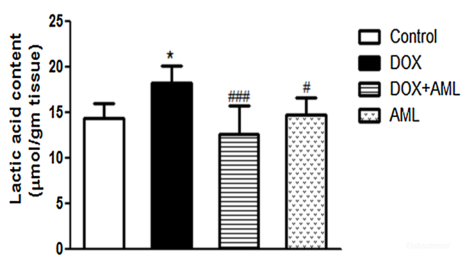L-Lactic Acid (LA) Colorimetric Assay Kit
SKU: E-BC-K044-S-100
To better serve you, we would like to discuss your specific requirement.
Please Contact Us for a quote.
L-Lactic Acid (LA) Colorimetric Assay Kit
| SKU # | E-BC-K044-S |
| Detection Instrument | Spectrophotometer(530 nm) |
| Detection Method | Colorimetric method |
Product Details
Properties
| Sample Type | Serum, plasma, cell culture supernatant, tissue, cells |
| Sensitivity | 0.05 mmol/L |
| Detection Range | 0.05-6.0 mmol/L |
| Detection Method | Colorimetric method |
| Assay type | Quantitative |
| Assay time | 60 min |
| Precision | Average inter-assay CV: 1.900% | Average intra-assay CV: 1.100% |
| Other instruments required | Micropipettor, Vortex mixer, Incubator, Centrifuge |
| Other reagents required | Normal saline (0.9% NaCl), PBS (0.01 M, pH 7.4) |
| Storage | 2-8℃ |
| Valid period | 12 months |
Images
A E Ali investigate the antitumor effects of AML and its ability to mitigate cancer resistance to DOX therapy. L-Lactate (L-LA) of rat hippocampal was determined using L-lactate colorimetric assay kit (E-BC-K044-S).

DOX administration significantly increased hippocampal lactic acid content (*P<0.05 vs. Control group), AML co-treatment significantly lowered hippocampal lactic acid content to near control levels. AML alone treated rats showed no significant difference when compared to control group. (#P<0.05 and ###P<0.001 vs. DOX group)
Dilution of Sample
It is recommended to take 2~3 samples with expected large difference to do pre-experiment before formal experiment and dilute the sample according to the result of the pre-experiment and the detection range (0.05-6.0 mmol/L).
The recommended dilution factor for different samples is as follows (for reference only):
| Sample type | Dilution factor |
| Human serum | 4-8 |
| 10% Mouse muscle tissue homogenization | 2-4 |
| 10% Mouse liver tissue homogenization | 1 |
| Rat serum | 4-8 |
| HePG2 cells homogenization (1.388 gprot/L) | 4-8 |
| HepG2 supernatant | 2-4 |
Note: The diluent is normal saline (0.9% NaCl) or PBS (0.01 M, pH 7.4).
Detection Principle
Using NAD+ as hydrogen acceptor, LDH catalyzes the conversion of both lactate and NAD+ into pyruvic acid and NADH respectively. 1-Methoxy-5-methyl phenazine methyl sulfate (PMS) transfers hydrogen from NADH to NBT which deoxidize into purple chromogenic substrate. Lactic acid content can be calculated by measuring the OD value at 530 nm.
Kit Components & Storage
| Item | Component | Size 1 (50 assays) | Size 2 (100 assays) | Storage |
| Reagent 1 | Buffer Solution | 60 mL × 1 vial | 6 mL × 2 vials | 2-8℃, 12 months |
| Reagent 2 | Enzyme Stock Solution | 0.6 mL × 1 vial | 1.2 mL × 1 vial | 2-8℃, 12 months |
| Reagent 3 | Chromogenic Agent |
12 mL × 1 vial | 24 mL × 1 vial | 2-8℃, 12 months shading light |
| Reagent 4 | Stop Solution | 60 mL × 2 vials | 60 mL × 4 vials | 2-8℃, 12 months |
| Reagent 5 | 3 mmol/L Lactic Acid Standard |
2 mL × 1 vial | 2 mL × 1 vial | 2-8℃, 12 months |
Note: The reagents must be stored strictly according to the preservation conditions in the above table. The reagents in different kits cannot be mixed with each other. For a small volume of reagents, please centrifuge before use, so as not to obtain sufficient amount of reagents.
Technical Data:
Parameter:
Intra-assay Precision
Three human serum samples were assayed in replicates of 20 to determine precision within an assay (CV = Coefficient of Variation).
| Parameters | Sample 1 | Sample 2 | Sample 3 |
| Mean (mmol/L) | 0.65 | 2.40 | 5.60 |
| %CV | 1.3 | 1.0 | 1.0 |
Inter-assay Precision
Three human serum samples were assayed 20 times in duplicate by three operators to determine precision between assays.
| Parameters | Sample 1 | Sample 2 | Sample 3 |
| Mean (mmol/L) | 0.65 | 2.40 | 5.60 |
| %CV | 1.8 | 2.0 | 1.9 |
Recovery
Take three samples of high concentration, middle concentration and low concentration to test the samples of each concentration for 6 times parallelly to get the average recovery rate of 101%.
| Sample 1 | Sample 2 | Sample 3 | |
| Expected Conc. (mmol/L) | 1.5 | 3.6 | 4.8 |
| Observed Conc. (mmol/L) | 1.5 | 3.6 | 4.9 |
| Recovery rate (%) | 99 | 101 | 103 |
Sensitivity
The analytical sensitivity of the assay is 0.05 mmol/L. This was determined by adding two standard deviations to the mean O.D. obtained when the zero standard was assayed 20 times, and calculating the corresponding concentration.



